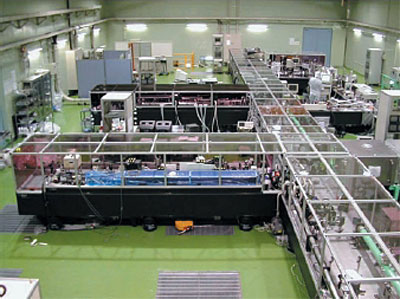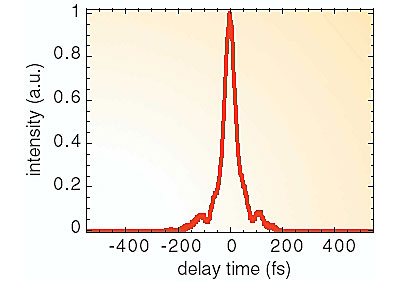There are various types of light sources in the world such as fluorescent lights, electric light bulbs, lasers, etc. What is the strength of the strongest light that humans can make with such light sources?
The advent of chirped pulse amplification (Fig. 5-1) used as the method of amplifying laser light is making it possible to generate immensely stronger light than mankind has previously brought forth. We have successfully produced for the first time, a petawatt (a thousand trillion watts) power level laser light from a laboratory-scale laser system. By focusing this laser light, we can create an enormous optical electrical field of more than 1021 W/cm2. This optical electrical field disassembles atoms and then instantly accelerates the resulting electrons to near light velocity. The masses of the electrons change following relativistic laws.
To construct this compact laser system having an output of nearly a petawatt, we have developed a system that reduces the emission time (pulse duration) of laser light and enhances amplification efficiency to the theoretical limit. However, amplifying the laser light to the petawatt level modifies the spectrum of the laser light, which disrupts the reduction of the pulse duration. We have resolved this problem by developing a technique that adjusts the spectral shape using two thin film filters. Furthermore, there was another problem, which was unwanted emission in the Titanium sapphire (Ti:sapphire) laser crystal. This emission, which is called "parasitic oscillation," decreases the amplification efficiency. To solve this issue, we have developed a technique where the edge of the crystal is covered with a specific absorbing plastic. The resulting laboratory-scale Ti:sapphire laser system (Fig. 5-2) can produce 850 trillion watts in thirty trillionths of a second (33 fs) (Fig. 5-3).
This laser system can promote new research frontiers in physical phenomenon under ultrahigh intensity light, ultrahigh pressure, and ultrahigh density. For example, these types of research may lead to the realization of a compact radiation source system that contributes to applications in medical diagnosis, and the downsizing and ready availability of devices using high-energy particles for cancer therapy.
|


